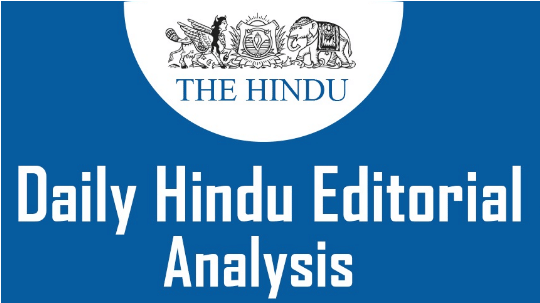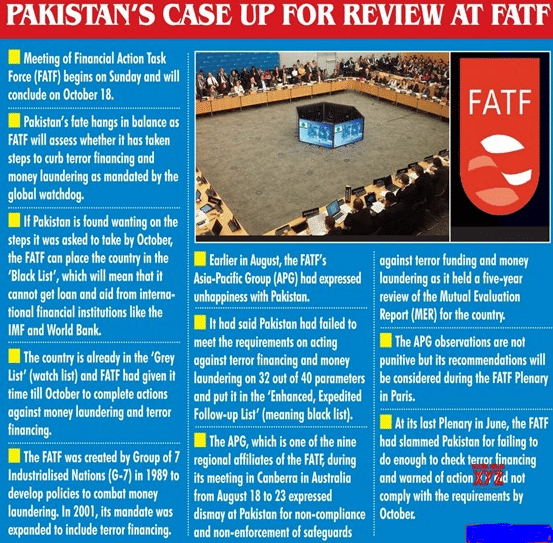The Hindu Editorial Analysis- 27th October, 2020 | Additional Study Material for UPSC PDF Download

1. THE SHADE OF GREY-
GS 2- Important International institutions, agencies and fora, their structure, mandate
Context
The decision by the Paris-based watchdog, the Financial Action Task Force, last week to retain Pakistan on its greylist has clearly disappointed the Imran Khan government.

International Strictures
(i) His cabinet had projected confidence that the country would be taken off the greylist, having been cleared on 21 of the 27 mandated action points.
(ii) Pakistan will now face international strictures(control) on its markets and on its ability to procure loans until the next FATF plenary in February 2021, by which time it is expected to complete the six pending issues.
(iii) A bigger problem for Islamabad was that Turkey was the only other country in the 39-member FATF to push for Pakistan to be let off, by making a suggestion that the last six points be cleared by an “on-site” visit by an FATF team.
(iv) The proposal was dropped when even other traditional backers of Pakistan such as China, Saudi Arabia and Malaysia did not support it.
(v) Clearly, Pakistan has little option but to complete its tasks in the next four months, which include-
(a) more action against UNSC-banned terrorists and terror groups,
(b) action against charitable organisations (Non-Profits) linked to these banned entities,
(c) tracing fugitive(escapee) terrorists and pursuing convictions against them,
(d) revising the list of banned entities under the Anti-Terrorism Act to reflect all those banned by the UNSC, and;
(e) cracking down on other channels of terror financing through narcotics and smuggling.
Broader Dividends
(i) For those in New Delhi watching the outcome of the FATF decision, there are some broader dividends to consider from this process.
(ii) To begin with, the fact that the FATF has retained Pakistan on the greylist for the third time this year, and not automatically downgraded it to the blacklist (with Iran and North Korea) when its deadline for action ended in September 2019, has ensured the pressure has continued to make Pakistan accountable on terror.
(iii) The Khan government has been forced to make a real legislative push to bring Pakistani anti-terror laws in line with international standards.
(iv) Also, for the interim, ensuring sufficient pressure on groups such as the LeT and the JeM that target India, to refrain from public comments and publicly raising funds.
(v) Meanwhile, Pakistan’s support to the U.S.-led Afghan process and talks with the Taliban are crucial to the peace process, and the FATF process has made Islamabad more amenable(manageable) to helping Afghanistan.
(vi) It remains to be seen if the actions it takes will permanently change Pakistan’s course in supporting and sheltering cross-border terror groups.
(vii) India’s eventual goal is not just in stopping attacks by these groups, but for Pakistan to fully dismantle(destroy) the infrastructure of terror in the understanding that it is in Pakistan’s own interests to do so.
(viii) It is hoped that the prolonged FATF process will enable this realisation in Islamabad.
Conclusion
Pakistan has little option but to complete its FATF mandated tasks in the next four months
2. CLEARING THE AIR-
GS 3- Conservation, environmental pollution and degradation, environmental impact assessment
Context
(i) President Trump’s scathing(strict) description of India’s air as “filthy(dirty)” may have come as an embarrassment for the government.
(ii) It has not provoked a fierce(strong) nationalistic backlash in response to a foreign leader’s insult.

Unwarranted Criticism
(i) The U.S. President’s remarks are, of course, gratuitous(unjustified), considering that he has spent his term dismantling(breaking) many environmental regulations.
(ii) His criticism of India and China is also incongruent(inconsistent) as they have pledged to implement the Paris Agreement while Mr. Trump has pulled the U.S. out of the pact.
(iii) Unfortunately, mere resolve cannot raise India’s stature.
(iv) Sensors of the Central and State Pollution Control Boards and other private stations across the north currently show PM2.5, or fine particulate matter levels, in the very unhealthy or even hazardous bands.
(v) There is mounting concern about the health impacts, but the Centre has so far attempted to brazen it out by denying any confirmed link between bad air quality and a shorter lifespan.
(vi) Environment Minister Prakash Javadekar last year said no Indian study on such a correlation was available.
(vii) That view has been challenged, and WHO expressed worry about the situation.
(viii) There is the added dimension of COVID-19 infection today, with the Harvard T.H. Chan School of Public Health contending that a 1 mg rise in PM2.5 is associated with an 8% increase in the death rate due to the novel coronavirus, based on long-term exposure data in the U.S.
Hastening Process
(i) India is seeking to address its chronic air quality crisis partly by raising emission standards and fuels.
(ii) The country adopted the BS-VI fuel standard earlier this year, potentially lowering vehicular pollution.
(iii) The national air quality standard for annual average PM2.5 is 40 mcg per cubic metre, which is four times the WHO limit.
(iv) It took the COVID-19 lockdown to let people experience clean air once again, with the conspicuous(clear) absence of vehicles.
(v) The unlock phase has reversed the ephemeral(passing) experience, as the burning of vehicular fuels has reverted to pre-lockdown levels, with no significant transition to green mobility, such as bicycle use, in urban centres.
(vi) Continued burning of crop stubble in Punjab, Haryana and Uttar Pradesh shows that the central sector scheme providing remedies in the form of farm mechanisation and management alternatives needs fresh impetus.
(vii) No more time can be lost in addressing the crisis of foul(dirty) air, as the country prepares to hasten(fasten) with development in a post-COVID-19 era.
Conclusion
Trump’s criticism may be gratuitous(unwarranted), but India’s air quality needs urgent attention.
3. CONTESTING NEIGHBOURS, REVISED GEOPOLITICAL PLAYBOOKS-
GS 2- Effect of policies and politics of developed and developing countries on India’s interests, Indian diaspora
Context
(i) The year 2020 has been a watershed(significant) moment for relations between India and China following the most serious clashes between the two countries in the Galwan region of Ladakh since the 1962 war.
(ii) Now, relations between New Delhi and Beijing are at new lows.
(iii) These events have had a cascading(spilling) effect on the very thought process of foreign policy, not just for New Delhi with regard to its neighbourhood but also Beijing’s understanding of its own threat perceptions as well.
What Dictates Alignment Now
(i) Strategic autonomy is today a term New Delhi’s power corridor are well-acquainted(aware) with.
(ii) According to a former Foreign Secretary of India, Vijay Gokhale, the ideation of ‘strategic autonomy’ is much different from the Nehruvian era thinking of ‘non-alignment’.
(iii) Speaking in January 2019, Mr. Gokhale said: “The alignment is issue based, and not ideological.”
(iv) For Beijing and New Delhi, one region where both contesting neighbours have employed similar versions of ‘non-alignment’ thinking is in West Asia.
(v) The ethos of equitable engagement with the three poles of power in Saudi Arabia, Iran and Israel, without stepping into the entanglements(fights) of the region’s multi-layered conflicts and political fissures(divisions).
(vi) Such were the commonalities in thinking that at one point in time, suggestions were made to construct an ‘importers OPEC’ in order to put forward the interests of major oil importers, mostly developing Asian economies, against the producers’ cartel.
Geopolitical Shifts
(i) However, the year 2020 and the tectonic geopolitical shifts it has brought in its wake, is forcing a drastic change in the geopolitical playbooks of the two Asian giants, and, by association, global security architectures as well.
(ii) Pre-dating 2020, India’s outreach to West Asia sharpened since 2014 with the coming of the Narendra Modi government.
(iii) The powerful and oil-rich Gulf states looked for investment alternatives away from the West to deepen their own strategic depth.
(iv) They got persuaded by Mr. Modi’s centralised decision-making style, India doubled down on its relations with the likes of Abu Dhabi and Riyadh, giving open economic and political preference to the larger Gulf region.
(v) While engagements with Israel moved steadily forward, Iran lagged behind, bogged down by U.S. sanctions, which in turn significantly slowed the pace of India-Iran engagements.
Advantage Beijing
(i) Meanwhile, China’s overtures(openings) have been steadily more adventurous as it realises two major shifts that have taken place in West Asia.
(ii) First, Beijing has tried to capitalise around the thinking in the Gulf that the American security safety net is not absolute, and they need to invest more in others.
(iii) China, being second only to the U.S. in both economic and military terms today, is the obvious engagement.
(iv) The fact that the UAE obtained Chinese Wing Loong drones in 2016 — a copy of U.S.’s infamous armed MQ-9 ‘Reaper’ drone that Washington refused to sell — offers a good example of the Gulf’s resolve of attaining military capabilities from wherever possible.
(v) Second, the Gulf economies such as Saudi Arabia, even though attempting a hard shift away from their addiction to the petro dollar, will still need growing markets to sell oil to in the coming decade as they reform their economic systems.
(vi) The obvious two markets here are China and India.
Sharp Contrasts
(i) However, Beijing’s recent plays in the region have not been subtle.
(ii) A report in September shone light on a $400 billion, 25-year understanding between Iran and China, with Beijing taking advantage of U.S. President Donald Trump’s abandonment of the Iran nuclear deal.
(iii) China is no longer happy with a passive role in West Asia.
(iv) Through concepts such as “negative peace” and “peace through development”, in concert with tools such as the Belt and Road Initiative, Beijing is now ready to offer an alternative model for “investment and influence”.
(v) Over the past month, Chinese Foreign Minister Wang Yi during an in-person meet with Iranian Foreign Minister Mohammad Javad Zarif suggested the development of a “new forum” to address the region’s tensions — an alternative to the West-led ecosystems that have prevailed for decades.
(vi) It remains to be seen, however, how China balances itself between the poles of power while backing one so aggressively.
(vii) From India’s perspective, it maintains its trapeze-wire balancing act of diplomacy in West Asia.
(viii) The overt outreach to the Gulf and the ensuing announcements of multi-billion-dollar investments on Indian shores by entities from Saudi Arabia and the UAE is only New Delhi recognising the economic realities of the region.
(ix) Despite entanglements in the Yemen war and general tensions between the Gulf states and Iran, the likes of Saudi Arabia, the UAE and so on have maintained relatively strong and stable economic progression.
(x) Israel’s recent peace accords with the UAE and Bahrain add much further weight towards a more stable Gulf region.
Conclusion
(i) The theory of interests superseding ideology in foreign policy is fast unravelling practically, both from the perspectives of India and China.
(ii) While in the recent past, the Indo-Pacific, with the development of the Quad, has taken centre stage, other geographies such as West Asia have also started to showcase bolder examples of New Delhi and Beijing’s metamorphosing(changing) approaches towards the international arena.
|
21 videos|562 docs|160 tests
|
FAQs on The Hindu Editorial Analysis- 27th October, 2020 - Additional Study Material for UPSC
| 1. What is the significance of reading The Hindu editorial for UPSC preparation? |  |
| 2. How can The Hindu editorial analysis help in improving answer writing skills for UPSC exam? |  |
| 3. What are the key points to consider while reading The Hindu editorial for UPSC exam? |  |
| 4. How can the UPSC aspirants make the most out of The Hindu editorial analysis? |  |
| 5. Are there any specific strategies to effectively incorporate The Hindu editorial analysis in UPSC preparation? |  |
















